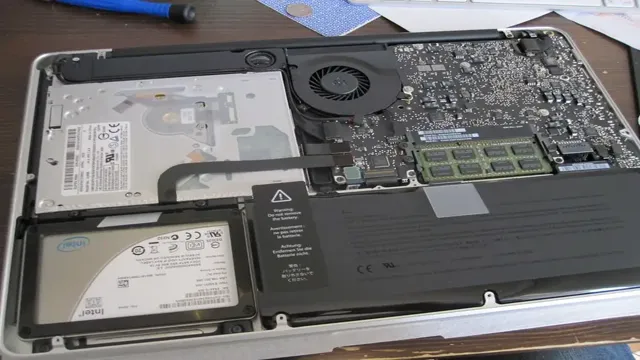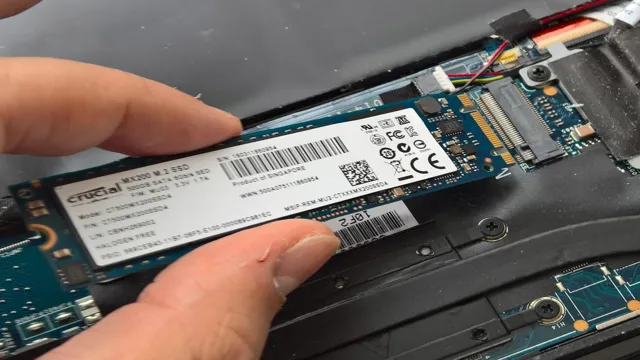Choosing the right Solid State Drive (SSD) can be challenging, especially if you’re not tech-savvy. With so many options to choose from, it’s easy to get overwhelmed and confused. However, with the right information, you can confidently make informed choices.
In this blog, we’ll discuss the factors to consider when selecting a compatible SSD and how to optimize your computer’s speed, storage, and performance. We’ll also provide tips to help you determine if you need an SSD upgrade and what to look for when shopping for one. So, fasten your seatbelts and get ready for an exciting ride!
Check Your PC’s Specifications
If you’re looking to upgrade your PC with a new SSD, it’s important to make sure it’s compatible with your current system. One way to find out is by checking your PC’s specifications. This can usually be done by going to your computer’s Control Panel, selecting the System and Security option, and then clicking on System.
Here, you should be able to find information such as your processor type and speed, amount of RAM, and available hard drive space. Once you have this information, you can look up the recommended specifications for the SSD you’re interested in and compare them to your system’s specs. Bear in mind that some SSDs may require certain connections or slots, so double-check that your PC has what’s needed.
With a little research, you can find the right SSD for your needs and give your PC a significant boost in speed and performance.
Step 1: Determine Your PC’s Interface Type
Before you can determine the correct interface for your computer, it is important to check its specifications. This ensures that you purchase the correct interface for your needs. To check your PC’s specifications, there are a few different methods you can use.
The first method involves checking the user manual or documentation that came with your computer. This typically includes detailed information about the hardware components in your PC. Another option is to use the System Information tool that is included in most versions of Windows.
This tool provides a detailed summary of your hardware components, including your computer’s interface type. By knowing your PC’s interface type, you can ensure that you purchase the correct interface to meet your needs.

Step 2: Check Your Motherboard Model
To check your PC’s specifications, it’s important to identify your motherboard model. This information will come in handy when you need to upgrade your computer’s hardware. To find your motherboard model, you can check the user manual that came with your system.
If you no longer have the user manual, you can find the information on the motherboard itself. This means opening up your computer case and looking for a sticker or label that has the model number printed on it. The motherboard is the main component that connects all the other parts of your computer, so its model number is crucial to know when upgrading your computer’s RAM or adding a new graphics card.
Once you have identified your motherboard model, you can start researching compatible upgrades and get the most out of your computer’s performance.
Step 3: Verify the Current SSD Connection
Before proceeding with the SSD installation, it’s important to ensure that your computer supports the new drive. Start by verifying your PC’s specifications and checking the current SSD connection. This step is crucial as some older computers might not support the latest SSD models.
Look up your computer model and check the manual for guidance or search the manufacturer’s website for compatibility details. Additionally, you can check if your computer is compatible with NVMe or SATA interface, which will determine the type of SSD you can install. An easy way to verify the current SSD connection is by opening the device manager and checking the disk drives category.
Here, you will find the current SSD model and connection type. If you’re not sure, reach out to a professional or a friend who has experience upgrading their computer’s storage. By ensuring your PC is compatible with the new SSD drive, you can avoid any unexpected issues or complications during and after the installation process.
Consider Your Upgrade Goals
If you’re wondering how to know what SSD is compatible with your PC, the first step is to consider your upgrade goals. Are you looking to simply improve boot and load times, or do you need more storage space for large files such as videos or games? Once you know what you want to achieve, take a look at your motherboard and determine what type of SSD connector it has. The most common types are SATA and NVMe, with NVMe offering faster speeds but also being more expensive.
You’ll also want to check the form factor of your current hard drive to ensure the SSD you choose will fit properly in your PC. Keep in mind that installing an SSD may require additional software updates or driver installations, so be sure to do your research beforehand. With the right SSD and a bit of know-how, you can give your PC a performance boost that will make a noticeable difference in your daily use.
Step 1: Determine Your Storage Needs
When determining your storage needs, it’s important to consider your upgrade goals. Think about what you want to achieve with your storage system in the future and how much space you will need to achieve those goals. Are you planning to expand your business or personal data? Do you want to keep all of your files in one central location or multiple locations for better organization and accessibility? By considering your upgrade goals, you can better determine your storage needs and choose a suitable system that will allow for future growth and expansion.
Remember, investing in a robust storage solution now will save you time and money in the long run and ensure that your data remains secure and accessible.
Step 2: Decide on the Type of SSD
When deciding on the type of SSD, it’s essential to consider your upgrade goals. There are two types of SSDs: SATA and NVMe. SATA SSDs are more affordable, and they use the same interface as traditional hard drives.
However, they have slower speeds and may not be suitable for high-performance computing tasks. On the other hand, NVMe SSDs are more expensive, but they offer faster speeds and better performance for intensive tasks such as gaming, video editing, and 3D rendering. If you’re looking to upgrade your storage for casual use, a SATA SSD may be the right choice for you.
But if you’re looking to handle more demanding tasks, an NVMe SSD may be worth the investment. Ultimately, your upgrade goals will determine the type of SSD that’s most appropriate for you.
Step 3: Consider the Form Factor
When it comes to selecting the right form factor for your upgrade goals, there are a few factors to consider. First, think about what you need from your device. Are you looking for something more portable and lightweight? Or do you need a larger screen and more processing power? This will help you narrow down your options.
You should also consider the types of upgrades you plan on making in the future. If you anticipate needing to add more hardware or components, you’ll want to select a form factor that can accommodate those changes. Keep in mind that each form factor has its own strengths and weaknesses, so it’s important to do your research before making a decision.
By considering your upgrade goals and assessing your needs, you can select a form factor that best suits your lifestyle and preferences.
Compatibility with Operating System
If you’re looking to upgrade your PC’s storage capacity, one of the best options is to replace your traditional hard drive with a solid-state drive (SSD). However, before you make a purchase, it’s important to ensure that your new SSD is compatible with your operating system. One of the easiest ways to know what SSD is compatible with your PC is to check the system requirements of your operating system.
Different operating systems have different requirements when it comes to hardware like SSDs, so it’s essential to make sure you’re getting a product that meets those requirements. For instance, if you’re running Windows 10, you’ll need an SSD that supports the NVMe protocol to get optimal performance. On the other hand, if you’re using an older operating system like Windows 7, you may need an SSD that’s compatible with the legacy SATA protocol.
By doing your research beforehand, you can get an SSD that’s the perfect fit for your PC and start enjoying faster boot times and improved load speeds.
Step 1: Check Your OS Compatibility
When it comes to installing software on your computer, it’s crucial to check whether it’s compatible with your operating system. Not every program is designed to work with every OS, which can cause compatibility issues that make it challenging to use or potentially damage your system. That’s why the first step in installing any software is to ensure that it’s compatible with your operating system.
Depending on your OS, you may be limited in your options when it comes to software, but it’s better to make sure than risk causing issues down the line. Doing a quick online search or checking with the vendor can help you make sure that whatever program you’re looking to install will work with your OS. By doing this, you’ll save yourself time, frustration, and potential headaches.
Step 2: Install the Correct Drivers
When it comes to installing the correct drivers for your hardware, compatibility with your operating system is key. Installing drivers that aren’t compatible with your OS can result in device malfunction or even system crashes. That’s why it’s important to take the time to research and download drivers specifically designed for your operating system.
For example, if you’re using Windows 10, be sure to download drivers that are optimized for that version of Windows. Installing drivers for an older version of Windows may not work properly or cause compatibility issues. Take the extra steps to ensure your drivers are compatible with your operating system to avoid any technical difficulties down the line.
Conclusion
In conclusion, determining which SSD is compatible with your PC is like finding a puzzle piece that fits perfectly. It requires careful consideration of factors like socket type, interface, and form factor. But fear not, with a little research and a keen eye for detail, you’ll find the SSD that slides seamlessly into your system and elevates your computing experience to the next level.
Happy hunting!”
FAQs
What is an SSD and how is it different from an HDD?
A Solid State Drive (SSD) and Hard Disk Drive (HDD) are two different types of storage devices. SSDs are faster and more reliable than HDDs, and are made up of flash memory chips while HDDs have spinning disks.
How do I find out what type of SSD is compatible with my PC?
The best way to find out what type of SSD is compatible with your PC is to check the specifications of your motherboard or computer model. Check for the type of SSD interface (SATA, M.2, or PCIe) that your motherboard or computer supports.
Can I upgrade my PC with an SSD if it already has an HDD?
Yes, you can upgrade your PC with an SSD even if it already has an HDD. You will need to clone your HDD to the SSD and then replace it with the HDD.
What are the benefits of upgrading to an SSD?
Upgrading to an SSD can significantly improve your computer’s speed and performance. It can also reduce boot times and application load times. Additionally, SSDs are more durable and reliable than HDDs.
